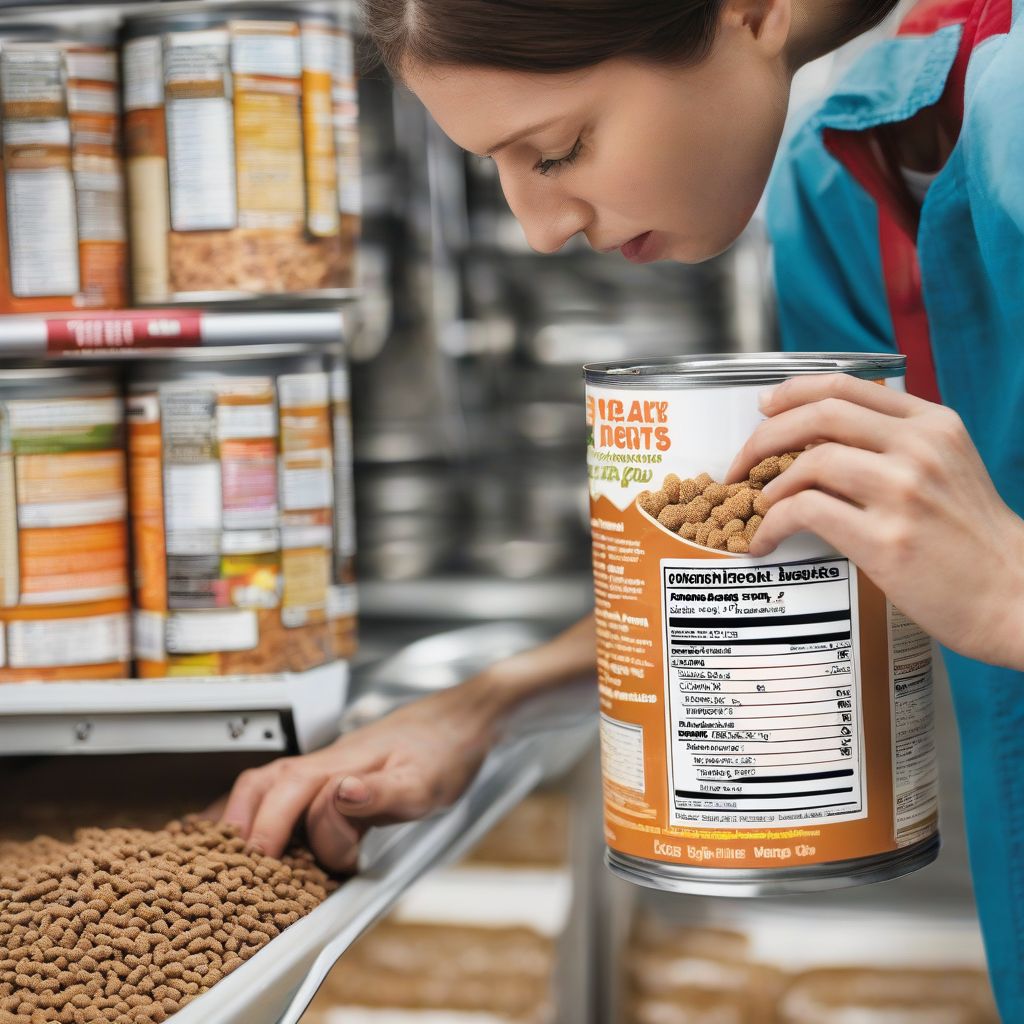Ever stood in the pet food aisle, overwhelmed by the sheer variety of choices? You’re not alone. Deciphering pet food labels can feel like learning a new language. But understanding what you’re feeding your furry friend is crucial for their health and well-being. As a certified nutritionist and meal prep coach, I’m here to break down the mystery of pet food labels and empower you to make informed choices.
Decoding the Front of the Pet Food Label
The front of the pet food label is like a billboard, designed to catch your eye. While it provides some basic information, it’s important to remember that this is marketing, not the full story. Here’s what to look for:
Product Name and Brand
This seems obvious, but pay attention to descriptive terms like “beef dinner” versus “beef.” “Dinner” implies the named ingredient makes up only 25% of the product, excluding water. “With beef” means only 3%.
Intended Species
Ensure the food is formulated for your pet – dog or cat, puppy or adult. Feeding the wrong type can lead to nutritional deficiencies.
Net Weight
This tells you how much food is in the package. Compare prices based on weight, not just package size.
 Reading Pet Food Label
Reading Pet Food Label
Unraveling the Information Panel: The Ingredient List
The ingredient list is the heart of the pet food label. Here, ingredients are listed in descending order by weight, including moisture content. This means the first ingredient is the most prevalent in the food.
Identifying High-Quality Ingredients
Look for whole meat sources, like chicken, beef, or fish, as the primary ingredients. Avoid generic terms like “meat by-products,” which can be low-quality and less digestible. Whole grains, fruits, and vegetables are also desirable.
Recognizing Potential Red Flags
Artificial colors, flavors, and preservatives offer no nutritional value and can be harmful to some pets. “BHA,” “BHT,” and “ethoxyquin” are common preservatives to avoid.
Deciphering the Guaranteed Analysis
The guaranteed analysis provides minimum percentages of crude protein, crude fat, crude fiber, and moisture. It helps you compare different foods, but remember, these are minimums, not exact amounts.
Understanding Nutrient Requirements
Different life stages require varying nutrient levels. Puppies and kittens need higher protein and fat for growth, while senior pets might benefit from lower calorie options. Consult your veterinarian for specific recommendations.
Navigating the Nutritional Adequacy Statement
This statement indicates whether the food meets AAFCO (Association of American Feed Control Officials) standards for a complete and balanced diet. Look for a statement like “[Product Name] is formulated to meet the nutritional levels established by the AAFCO Dog/Cat Food Nutrient Profiles for [Life Stage].” This ensures the food meets minimum nutrient requirements.
Common Questions About Pet Food Labels
Here are some frequently asked questions about reading pet food labels:
What does “natural” mean on a pet food label?
According to AAFCO, “natural” means ingredients are derived from plant, animal, or mined sources, without chemical alteration. However, this term isn’t strictly regulated and can be misleading.
What are by-products?
By-products are parts of the animal carcass other than meat, such as organs, bones, and blood. While some can provide nutrients, others are less digestible and less desirable.
Why is grain-free pet food controversial?
While some pets have grain allergies, grain-free diets have been linked to heart disease in dogs. Consult your veterinarian before switching to a grain-free diet.
How can I tell if a pet food is appropriate for my pet’s allergies?
Look for limited ingredient diets or hydrolyzed protein formulas if your pet has allergies. Consult your veterinarian for guidance.
 Comparing Pet Food Labels
Comparing Pet Food Labels
Tips for Choosing the Right Pet Food
- Consult Your Veterinarian: They can offer personalized recommendations based on your pet’s breed, age, activity level, and health conditions.
- Rotate Foods: Offering variety can prevent nutrient deficiencies and boredom.
- Transition Gradually: Introduce new foods slowly to avoid digestive upset.
- Monitor Your Pet’s Response: Pay attention to their coat, energy levels, stool quality, and weight.
Conclusion
Reading pet food labels is a crucial part of responsible pet ownership. By understanding the information on the label, you can make informed decisions about what you’re feeding your furry companion, contributing to their overall health and happiness. Remember, your veterinarian is your best resource for personalized dietary advice. Don’t hesitate to reach out to them with any questions or concerns. What questions do you have about pet food labels? Share your thoughts in the comments below!



